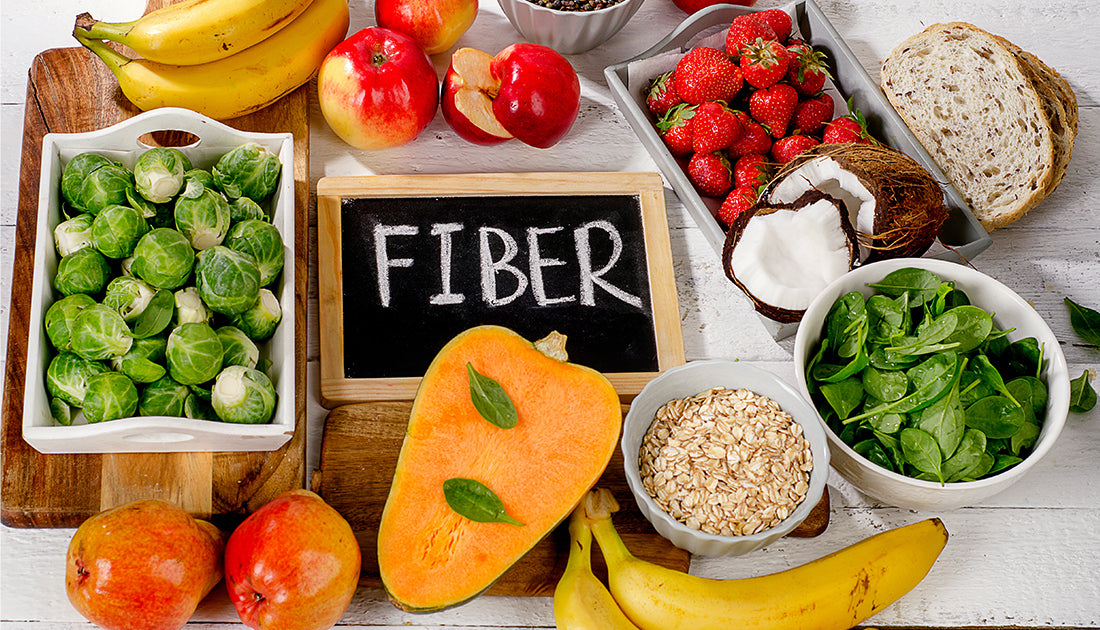We’re constantly reminded to eat enough fiber each day.
Current recommendations, per the 2015-2020 Dietary Guidelines, for fiber intake for adults is between 25-38 grams per day. This equates to approximately 14 grams of fiber per 1000 calories of food consumed.
However, the vast majority of Americans don’t even get half of their recommended intake of dietary fiber each day! <1,2>
Despite being told of the importance of fiber, many individuals don’t understand why fiber is needed in the diet or benefits are to be had from its inclusion in the diet.
Today, we'll discuss why adding fiber to a diet is essential and the benefits it may confer.
What Does Adding Fiber to Your Diet Do?
Fiber is the indigestible portion of carbohydrates contained in plant foods.
It adds volume and weight to your stool and softens it -- making it easier to pass, thereby reducing your risk of constipation. Conversely, loose stools can also be “bulked up” and solidified by fiber.
Fiber-rich foods also help you to feel fuller and slow down the speed of digestion, which reduces hunger and enables you to stay on track with your diet.
Finally, fiber also serves as food for the good bacteria in your gut, which supports gut health and function (and by extension immune function and cognitive function as the gut is heavily involved in both).
What Are the Benefits of Adding Fiber to Your Diet?
The role of fiber in the diet has been studied at great lengths.
Research notes that individuals with higher fiber intakes tend to have significantly lower rates of several major chronic diseases <3,4>, including:
- Type 2 Diabetes
- Obesity
- Hypertension (High Blood Pressure)
- Stroke
- Hyperlipidemia (High Cholesterol)
- Cardiovascular Disease
- Digestive Disorders
A 2019 meta-analysis including over 240 studies found that for every 8g increase of dietary fiber eaten per day, total deaths and incidences of type 2 diabetes, coronary heart disease, and colorectal cancer decreased between 5-27%. <4>
Furthermore, research also finds a strong correlation between individuals with higher fiber intakes and slimmer waistlines. <5>
Additional research has noted that for every 10 grams of soluble fiber intake, individuals had a 3.7% lower risk of gaining weight. <6>
How Does Fiber Help Boost Weight Loss?
Low in Calories
Foods high in fiber (fruits, vegetables, whole grains) generally are lower in calories compared to foods with little or no fiber.
Yet, due to the fiber content, these foods help you feel fuller while eating fewer total calories, meaning you’re less likely to overeat and stay on track with your diet plan.
Decreases Hunger
When we eat foods high in soluble fiber, it attracts water and slows down the rate of digestion, which helps you feel fuller.
Research shows that eating soluble fiber decreases the levels of ghrelin (the “hunger hormone”) produced by the body. <10>
Feeling less hungry following mealtime decreases the likelihood you'll want to snack between meals, which again helps you stay on track with your diet plan.
Supports Stable Blood Sugar Levels
Another added benefit of slower digestion (besides increased feelings of fullness), is that it slows the release of carbohydrates (sugar) into the bloodstream, which supports more steady blood sugar levels. <7>
More stable blood sugar levels may help protect against the development and progression of insulin resistance or diabetes.
Additionally, steady blood sugar levels also promote more stable energy levels throughout the day, avoiding the peaks and valleys that come with consuming high sugar, low fiber foods.
Supports a Healthy Gut
Not only does a high fiber intake help defend against weight gain, but it may also promote gut health.
Fermentable fiber is a particular type of soluble fiber that serves as "food" for the bacteria in your gut. These bacteria ferment (break down) these fibers to produce short-chain fatty acids (such as butyrate), which serve as the primary energy source for the cells lining your colon. What this means is that butyrate plays an essential role in the health and function of your colon. <8>
When gut bacteria don’t get sufficient amounts of food, they die (just as any organism would cease to exist if it didn’t get nutrition regularly).
Since the gut plays a crucial role in immune function, drastic alterations to its makeup can make us more susceptible to infection, illness, and disease.
Consuming adequate amounts of fiber help ensure that our gut bacteria receive enough food each day to thrive.
Lastly, recent studies also suggest that individuals with a greater diversity of gut bacteria have a decreased risk of visceral fat accumulation. <9>
How Does Fiber Help Reduce Belly Bloat?
Bloating is a common problem many people experience daily.
Typically, it occurs when your stomach looks and/or feels swollen after eating. Bloating can be caused by excessive gas production in the GI system, or from disturbances in peristalsis. <1,2>
It may also be caused by excessive amounts of liquids or solids in your digestive tract as well.
Many people also feel bloated when they are constipated. <11>
One of the most common recommendations to resolve constipation is to increase one’s intake of fiber. This helps draw more water to the GI tract and improve gastric motility to help “get things flowing” again.
However, it should be noted that fiber is a dual-edged sword as, for some individuals, consuming too much of it can lead to excessive gas production, bloating, and potential constipation. <12>
In addition to consuming sufficient amounts of fiber, individuals looking to combat constipation and bloating are recommended to engage in regular bouts of physical activity and drink enough water each day. <13,14>
Natural Food Sources of Fiber
Generally speaking, the best sources of fiber in the diet comes from plant foods -- fruits, vegetables, seeds, nuts, and whole grains.
Due to the wide variety of high-fiber foods, it is relatively easy to add to more fiber-rich foods to your diet, as there’s something to please everyone’s palate.
Foods that are high in soluble fiber include:
- Oatmeal
- Legumes
- Sweet Potatoes
- Flaxseeds
- Brussels Sprouts
- Avocados
Foods that are high in insoluble fiber include:
- Wheat bran
- Almonds
- Amaranth
- Kidney Beans
- Raspberries
- Apple (with skin)
Keep in mind that if you aren’t used to eating a lot of fiber each day, SLOWLY increase your daily fiber intake.
Going from a state where you are hardly consuming any fiber to a state where you are consuming lots of dietary fiber can lead to unwanted side effects, such as stomach cramps, diarrhea, and bloating.
As such, it's best to slowly increase your fiber intake over time to help your body more easily acclimate to the change in diet.
Best Fiber Supplements to Add to Your Diet
In an ideal world, we’d satisfy all of our nutritional requirements through food alone.
However, individuals often find themselves in a bind. They don't have time to eat enough high-quality foods each day, which means not only are you missing out on essential vitamins and minerals but fiber as well.
In these instances, having a high-quality fiber supplement can help.
SteelFit® Sunfiber® supplies 6 grams of soluble fiber (galactomannan) derived from partially hydrolyzed guar gum.
Guar gum fiber supplementation has been shown in various studies to help <15,16,17,18,19>:
- Increase Short-Term and Long-Term Satiety
- Reduce Between-Meal Snacking
- Lower Glycemic Index of a Meal
- Improve Mineral Absorption
- Support Digestive Health
Sunfiber® also comes without the excess gas or bloating that is typically associated with other dietary and supplemental fibers.
Moreover, Sunfiber® promotes regularity, intestinal and colon health, aids the transit of food through the intestines, and supports weight control by reducing hunger.* It’s even been shown to increase both Bifidobacteria and Lactobacillus levels -- two of the main bacteria present in the gut.
References
- King, D. E., Mainous, A. G. 3rd, & Lambourne, C. A. (2012). Trends in dietary fiber intake in the United States, 1999-2008. Journal of the Academy of Nutrition and Dietetics, 112(5), 642–648. https://doi.org/10.1016/j.jand.2012.01.019
- "Appendix 7. Nutritional Goals for Age-Sex Groups Based on Dietary Reference Intakes and Dietary Guidelines Recommendations - 2015-2020 Dietary Guidelines." Home of the Office of Disease Prevention and Health Promotion - Health.gov
- National Research Council (US) Committee on Diet and Health. Diet and Health: Implications for Reducing Chronic Disease Risk. Washington (DC): National Academies Press (US); 1989. 10, Dietary Fiber.
- Reynolds, A., Mann, J., Cummings, J., Winter, N., Mete, E., & Te Morenga, L. (2019). Carbohydrate quality and human health: a series of systematic reviews and meta-analyses. Lancet (London, England), 393(10170), 434–445. https://doi.org/10.1016/S0140-6736(18)31809-9
- Shay CM, Van Horn L, Stamler J, et al. Food and nutrient intakes and their associations with lower BMI in middle-aged US adults: the International Study of Macro-/Micronutrients and Blood Pressure (INTERMAP). Am J Clin Nutr. 2012;96(3):483–491. doi:10.3945/ajcn.111.025056
- Hairston KG, Vitolins MZ, Norris JM, Anderson AM, Hanley AJ, Wagenknecht LE. Lifestyle factors and 5-year abdominal fat accumulation in a minority cohort: the IRAS Family Study. Obesity (Silver Spring). 2012;20(2):421–427. doi:10.1038/oby.2011.171
- Riccardi, G., & Rivellese, A. A. (1991). Effects of dietary fiber and carbohydrate on glucose and lipoprotein metabolism in diabetic patients. Diabetes Care, 14(12), 1115–1125. https://doi.org/10.2337/diacare.14.12.1115
- Wong, J. M. W., de Souza, R., Kendall, C. W. C., Emam, A., & Jenkins, D. J. A. (2006). Colonic health: fermentation and short chain fatty acids. Journal of Clinical Gastroenterology, 40(3), 235–243.
- Beaumont M, Goodrich JK, Jackson MA, et al. Heritable components of the human fecal microbiome are associated with visceral fat. Genome Biol. 2016;17(1):189. Published 2016 Sep 26. doi:10.1186/s13059-016-1052-7
- St-Pierre, D. H., Rabasa-Lhoret, R., Lavoie, M.-E., Karelis, A. D., Strychar, I., Doucet, E., & Coderre, L. (2009). Fiber intake predicts ghrelin levels in overweight and obese postmenopausal women. European Journal of Endocrinology, 161(1), 65–72. https://doi.org/10.1530/EJE-09-0018
- Agrawal, A., Houghton, L. A., Reilly, B., Morris, J., & Whorwell, P. J. (2009). Bloating and distension in irritable bowel syndrome: the role of gastrointestinal transit. The American Journal of Gastroenterology, 104(8), 1998–2004. https://doi.org/10.1038/ajg.2009.251
- Muller-Lissner, S. A., Kamm, M. A., Scarpignato, C., & Wald, A. (2005). Myths and misconceptions about chronic constipation. The American Journal of Gastroenterology, 100(1), 232–242. https://doi.org/10.1111/j.1572-0241.2005.40885.x
- Schiller, L.R.. (2001), The therapy of constipation. Alimentary Pharmacology & Therapeutics, 15: 749-763. doi:10.1046/j.1365-2036.2001.00982.x
- Anneke M. De Schryver, Yolande C. Keulemans, Harry P. Peters, Louis M. Akkermans, André J. Smout, Wouter R. De Vries & Gerard P. Van Berge-Henegouwen (2005) Effects of regular physical activity on defecation pattern in middle-aged patients complaining of chronic constipation, Scandinavian Journal of Gastroenterology, 40:4, 422-429, DOI: 10.1080/00365520510011641
- Rao, T. P. (2016). Role of guar fiber in appetite control. Physiology & Behavior, 164(Pt A), 277–283. https://doi.org/10.1016/j.physbeh.2016.06.014
- Rao, T. P., Hayakawa, M., Minami, T., Ishihara, N., Kapoor, M. P., Ohkubo, T., … Wakabayashi, K. (2015). Post-meal perceivable satiety and subsequent energy intake with intake of partially hydrolysed guar gum. The British Journal of Nutrition, 113(9), 1489–1498. https://doi.org/10.1017/S0007114515000756
- Tokunaga, M., & et al. (2016). Effect of Partially Hydrolyzed Guar Gum on Postprandial Hyperglycemia―A Randomized Double—blind, Placebo—controlled Crossover—study―. 薬理と治療, 44(1).
- Okubo T, Ishihara N, Takahashi H, et al. Effects of partially hydrolyzed guar gum intake on human intestinal microflora and its metabolism. Biosci Biotechnol Biochem. 1994;58:1364–1369.
- Maenaka T, Yokawa T, Ishihara N, Gu Y, Juneja LR. Effects of partially hydrolyzed guar gum on postprandial blood glucose level and disaccharidase. J Jpn Soc Med Use Func Foods. 2007;4:195–201.

